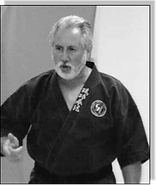
ZENKOKU RYUKYU KEMPO RENMEI
Traditional Okinawan Karate

Origin of Ryukyu Kempo - Cont'd
The Oriental characters of "Ryukyu Kempo" are of Chinese origin translated as "Lui Chiu-Chuen-Fa" meaning"Ryukyu islands fist law". These characters were used to describe a particular hard-style of karate taught on Okinawa.
When Gichin Funakoshi arrived in Tokyo in 1922, he published a book entitled "Ryukyu Kempo: Karate." That same year after publication, all plates and printings were destroyed in the Great Earthquake. In this book, Master Funakoshi makes a distinction between kempo and karate, stating he always felt there was a difference between the two arts. In his 1975 publication of "Karate-Do, My Way of Life," he refers to his earlier work and emphasizes the same view.
In Okinawan Master Choki Motobu's 1926 book entitled"Okinawa Kempo: Karate Jutsu on Kumite," he makes the same analogy and draws the same conclusion as Gichin Funakoshi.
In the early 1950's, Master Shigeru Nakamura chose the name "Okinawa Kenpo" to represent his system of karate. The 12-Empty Hand katas directly attributed to Master Nakamura, handed down from his teachers, are the foundation of our present day Ryukyu Kempo.
When the first American instructors returned from Okinawa to the United States in the early 1960's, we continued to use Nakamura's "Okinawa Kenpo." After his death in 1969, however, “Okinawa Kenpo” became a family entitlement creating a problem for those using the name.
When Taika Oyata first arrived in the United States in 1968, he was still teaching under Master Nakamura’s organization. Due to the sudden death of Master Nakamura and the severe winter conditions in the midwest, Taika returned to Okinawa.
For several years we communicated with Taika, during which time Bill Wiswell, Jim Logue and myself had formed the first Okinawan Kempo organization. Prior to Taika's return in 1974, we held a meeting to discuss the problems using Nakamura's system name "Okinawan Kenpo," as I had received several letters from a New York attorney addressing the corporate legal status. Bill Wiswell, at that time, owned Ryukyu Imports Inc. in Olathe, Kansas and suggested combining the characters for “Ryukyu” and “Kempo.”
As we walked through La Guardia Airport with Taika, he asked us in broken English “What you call your system?” We replied, “Ryukyu Kempo, Sensei.” To this day, I still remember his response,“Oh, this OK!” This was Taika Seiyu Oyata's very first sanction of the name "Ryukyu Kempo" in the United States.
In the airport parking lot, Taika asked us another question, “Where you wear my patch?” Jim and I looked at each other; almost at the same time, slapping our chest we said, “Over the heart, Sensei!” Again, he responded, “Oh, this OK!” A few steps later, he asked, “Where you wear your patch?” This time we slapped our upper arms (Thinking back, I think we slapped different arms!)
Ryukyu Kempo's 300-year heritage provides a specific traditional system of karate. The 12-Empty Hand katas we practice today are directly attributed to Master Nakamura, derived from his teachers, and are the foundation of our present day Ryukyu Kempo.
Zenkoku Ryukyu Kempo Karate-Do Renmei upholds tradition in its teachings offering a nationally recognized 12-Empty Hand Kata Certification seminar that will validate Ryukyu Kempo authenticity in the practice and teaching of these original katas.

Taika Oyata 5th Dan in All Japan karate Association, Albert Geraldi, Nidan, 1964

Makiminato Dojo, Okinawa, 1963

Bogu Kumite
Makiminato Dojo, Okinawa 1963
(Taika Oyata, right, sitting on stool)
Origin of Ryukyu Kempo
